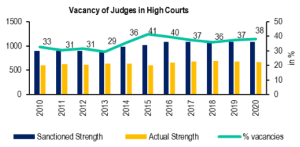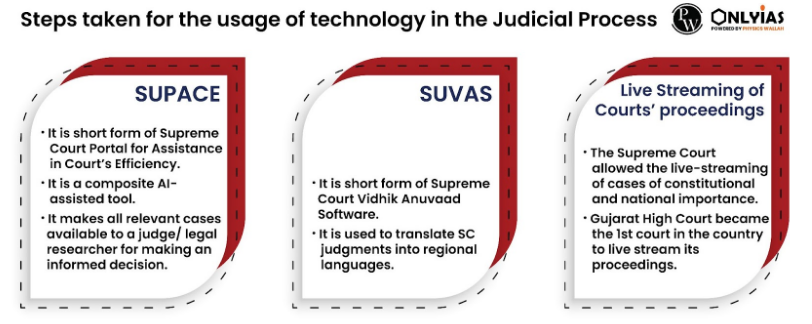Context:
The 133rd report of the Parliamentary Standing Committee on Personnel, Public Grievances, Law, and Justice underscores the imperative for a comprehensive strategy to alleviate case backlogs.
More on News:
- The Committee recognizes the historical origin of judicial vacations as a colonial legacy.
- The court takes two long vacations each year, the summer and winter breaks, but is technically not fully closed during these periods.
- It is evident that the collective suspension of court proceedings during such vacations causes substantial inconveniences to the litigants involved.
Key Recommendation of the Parliamentary Panel:
- Regional Benches of Supreme Courts: They suggested having courts in different parts of the country so people don’t have to travel far for justice.
- The committee recommended the SC to invoke Article 130 of the Constitution to establish its regional Benches at four or five locations in the country
- Post-retirement Assignments: The practice of post-retirement assignments to judges of the SC and high courts (HCs) in bodies financed from the public exchequer should be reassessed to ensure their impartiality.
- Judges’ Retirement Age: The retirement age of judges needed to be increased since longevity has increased due to advancements in medical sciences.
- More Diversity: The representation of the Scheduled Castes, Scheduled Tribes, women, and minorities in the higher judiciary is far below the desired levels and does not reflect the social diversity of the country.
- Adequate representation of various sections of Indian society will further strengthen the trust, credibility, and acceptability of the judiciary among the citizens.
- Change Vacation System: Instead of all judges being on vacation together, they suggested judges take time off at different times. This way, courts can stay open more often.
- Declare Assets: The committee said all constitutional functionaries and government servants must file annual returns of their assets and liabilities.
|
Current Status of Case Pendency in Indian Judiciary:
- Steady Increase in Backlog: Between 2010 and 2020, the pendency of cases in all courts increased by an annual rate of 2.8%.
- Concentration in Lower Judiciary: The most severe backlog of cases is found in the lower levels of the judiciary where most cases are filed.

- Pendency of cases in High Court: Over 59 lakh cases were pending in the High Courts until July 2022.
 Varied Regional Backlogs: The number of pending cases varies greatly across different states.
Varied Regional Backlogs: The number of pending cases varies greatly across different states.
- Some states, like Bihar and Uttar Pradesh, have exceptionally high numbers of unresolved cases.
- Bihar has more than 5 million pending cases, while Uttar Pradesh has over 6 million.
- Illustration of Tribunal Backlog: As of the end of 2020, the National Company Law Tribunal (NCLT) had a backlog of 21,259 cases.
Reasons for High Case Pendency in the Indian Judiciary:
- Shortage of Judges: The scarcity of judges within the Indian judiciary is a key factor contributing to the backlog.
 As on September 1, 2021, the Supreme Court had one vacancy out of the sanctioned strength of 34 judges.
As on September 1, 2021, the Supreme Court had one vacancy out of the sanctioned strength of 34 judges. - In the High Courts, 42% of the total sanctioned posts for judges were vacant (465 out of 1,098).
- As on February 20, 2020, in subordinate courts, 21% posts out of the sanctioned strength of judges were vacant.
- India has about 21 judges for every million people. China, by contrast, has about 159 judges for every million people.
- Court Vacations: The Supreme Court has 193 working days a year for its judicial functioning, while the High Courts function for approximately 210 days, and trial courts for 245 days.
- Too many vacations in the courts cause an unreasonable delay in the cases.
- Government Litigation: In 2018, the Law Commission of India, in its 230th report, noted that the government is the biggest litigant in the system.
- As on January 3,20223, LIMBS project (Legal Information Management Briefing System) shows that there are 6,20,000 cases involving the government pending before the court system.
- Inadequate Infrastructure: Many courts across India lack the necessary facilities and resources to effectively manage the high volume of cases filed. This deficiency in infrastructure can lead to delays in case resolution.
- Complexity of Cases: Certain cases are intricate and demand significant time and resources for thorough resolution. Complex cases tend to take longer to conclude, contributing to the overall backlog.
- Examples of cases that may be considered “complex litigation” might include environmental litigation, legal malpractice, medical malpractice, etc.
- Procedural Delays: Delays can arise due to procedural complications, such as difficulties in locating witnesses or obtaining essential evidence. These procedural obstacles can prolong the time it takes to reach a verdict.
- Low Enforcement of Court Orders: When court orders are not enforced, it leads to additional delays in case resolution. Non-compliance with court rulings undermines the effectiveness of the judicial process.
- New Mechanisms and Litigation: Innovative mechanisms like Public Interest Litigation (PIL) have expanded the scope of cases brought before the courts. While PIL is valuable for addressing public issues, it also contributes to the caseload.
- PIL is a legal mechanism that allows individuals or groups to approach the courts in order to address issues that affect the larger public or society’s interests.
Impact of Judicial Pendency on the Justice Delivery System in India:
- Delays in Justice: The accumulation of pending cases can result in considerable delays in resolving cases, extending the time it takes for individuals to receive a verdict.
- A State of the Indian Judiciary Report published in 2019 records that on average, at the district court level, a case remains pending for five years or more. If the losing side goes up in appeal, then the average time may go up to 13 years
- Compromised Quality of Justice: Due to the pressure of a heavy caseload, judges might not have adequate time to thoroughly assess and analyze each case. This can lead to decisions that may not be well-informed or fail to address the core issues effectively.
- Overwhelming the Court System: A significant backlog can strain the entire court system, making it challenging for judges to handle cases promptly and efficiently. This overload can disrupt the timely disposal of cases.
- Eroding Public Trust: Lengthy delays can erode public trust in the effectiveness of the legal system. People may lose confidence in the ability of the courts to deliver timely and fair justice.
- Financial Strain on Litigants: Prolonged legal proceedings can place a financial burden on litigants. They are required to bear the costs associated with ongoing legal battles, which can be financially taxing.
- Undertrials on the rise: Sharp spike in case pendency in Indian courts has resulted in an increase in the number of undertrials lodged in prisons.
- An undertrial is a prisoner on trial in a court of law. As per the Prison Statistics-2020, released by the National Crime Records Bureau (NCRB), undertrials accounted for 76% of the total inmates in around 1,300 prisons across the country.
Efforts Taken to Reduce Case Pendency:
- E-Courts Mission Mode Project:The eCourts Integrated Mission Mode Project is one of the National e- Governance projects being implemented in District and Subordinate Courts of the Country since 2007.
- It provide designated services to litigants, lawyers and the judiciary by universal computerisation of district and subordinate courts in the country.

- Virtual Courts: Conducting court proceedings through videoconferencing, improving access and speeding up cases.
- E-filing: E-filing allows cases to be submitted electronically over the internet, minimizing physical presence and paperwork. It accelerates case processing and reduces administrative delays.
- e-Payment: Online payment for court fees and fines, minimizing cash transactions and paperwork.
- Interoperable Criminal Justice System (ICJS): Data exchange among justice system components, aiding faster case resolution.
- Fast Track Courts: Dedicated courts for quick case handling, prioritizing backlog reduction.
- Alternative Dispute Resolution (ADR): Methods like Lok Adalats, Gram Nyayalayas, and Online Dispute Resolution offer alternate avenues for swift dispute resolution.
Way Forward:
- Increase the Number of Judges: One way to reduce the backlog of cases is to increase the number of judges in the Indian judiciary. This will allow more cases to be heard and decided more quickly.
- The Law Commission of India (1987) recommended increasing the number of judges to 50 per million people.
- This was reiterated by the Supreme Court (2001) and the Standing Committee on Home Affairs (2002).
|
- Judicial Workload Management: Implement strategies to distribute cases more evenly among judges and courts, preventing overburdening of specific courts and judges.
-
- Adopt modern case management techniques to track cases, allocate resources efficiently, and expedite hearings.
- Decrease Court Vacations: Extended frequent vacations are not good optics, especially in the light of mounting pendency of cases and the snail’s pace of judicial proceedings.
- For an ordinary litigant, the vacation means further unavoidable delays in listing cases.
Various Recommendations about Court Vacations:
- 2000: The Justice Malimath Committee, suggested that the Supreme Court work for 206 days, and High Courts for 231 days every year, keeping in mind the long pendency of cases.
- 2009: The Law Commission, in its 230th report had suggested that court vacation be cut down by 10-15 days across all levels of judiciary to help deal with pending cases.
- 2014: The Supreme Court notified its new Rules, it said that the period of summer vacation shall not exceed seven weeks from the earlier 10-week period.
|
- Efficient Utilization of Experienced Judges: Retain experienced judges beyond the retirement age of 62 with pay and perquisites to maximize their contribution to the justice system.
- Specialized Courts: Establish specialized courts for specific types of cases (e.g., commercial, family, environmental) to handle them more effectively and promptly.
- Clearing Archaic Laws: Review and repeal outdated laws that contribute to the backlog and focus on more relevant and current legal matters.
- Virtual Hearings Expansion: Further expand virtual court hearings to ensure cases can proceed even during emergencies and disruptions.
- Strengthening ADR: Promote the use of alternative dispute resolution methods like mediation, conciliation, and arbitration to resolve cases swiftly.
News Source: The Indian Express
![]() 9 Aug 2023
9 Aug 2023

 Varied Regional Backlogs: The number of pending cases varies greatly across different states.
Varied Regional Backlogs: The number of pending cases varies greatly across different states.
 As on September 1, 2021, the Supreme Court had one vacancy out of the sanctioned strength of 34 judges.
As on September 1, 2021, the Supreme Court had one vacancy out of the sanctioned strength of 34 judges. 
